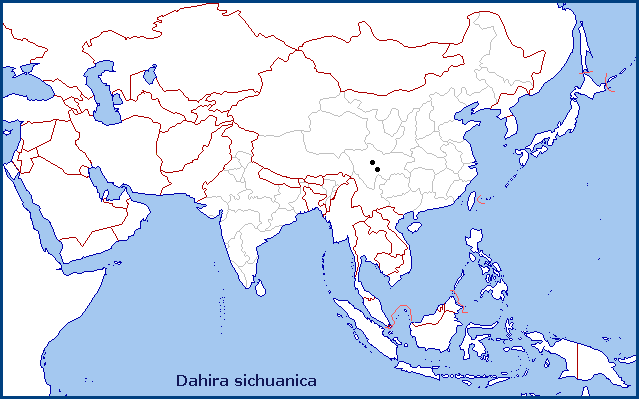![Dahira sichuanica (dorsal view), Dafengding Nature Reserve, Mabian County, Leshan City, Sichuan, China, 28°34'35''N, 103°15'12''E, 1580m [HOLOTYPE]. Photo: © ZhuoHeng Jiang. Dahira sichuanica (dorsal view), Dafengding Nature Reserve, Mabian County, Leshan City, Sichuan, China, 28°34'35''N, 103°15'12''E, 1580m [HOLOTYPE]. Photo: © ZhuoHeng Jiang.](l_sic_c1.jpg)
![Dahira sichuanica (ventral view), Dafengding Nature Reserve, Mabian County, Leshan City, Sichuan, China, 28°34'35''N, 103°15'12''E, 1580m [HOLOTYPE]. Photo: © ZhuoHeng Jiang. Dahira sichuanica (ventral view), Dafengding Nature Reserve, Mabian County, Leshan City, Sichuan, China, 28°34'35''N, 103°15'12''E, 1580m [HOLOTYPE]. Photo: © ZhuoHeng Jiang.](l_sic_c2.jpg)
Dahira sichuanica Jiang & Wang, 2020, Zootaxa 4767 (3): 486. Type locality: China, Sichuan, Leshan City, Mabian County, Dafengding Nature Reserve, 28°34'35''N, 103°15'12''E, 1580m (leg. Fei Lu).
65mm. In the male, head, thorax, and abdomen grey with a purplish overtone; head and thorax with a deep brown, longitudinal, medial band. Antennae filiform, brownish yellow, apically hooked. Labial palpus protruding, greyish brown. Forewing elongate, apex acute, termen oblique, slightly excavated below the apex and between M3 and CuA1. Upperside ground colour greyish brown, with exception of a dark brown 'Y'-shaped transverse bar, running from the centre of the costa to two thirds of the length of the termen (between CuA1 and CuA2); another indistinct bar running from the anterior of the forewing costa to M3. Apical region between veins R3+4 and M3 with numerous scattered blackish scales. Antemedial bands near FW base narrow, curved and likewise darker brown. HW rather broad and rounded, termen oblique and slightly excavate between M1 and CuA1. Abdomen upperside concolorous with wings, with blackish-grey transverse bands along the posterior margins of tergites. Underside of both wings predominantly reddish-brown. HW with five evenly spaced, curved postmedial brown lines. Transverse lines of FW underside similar, but rather indistinct; marginal band dark grey, with deepest indentation between M2 and M3. Underside of abdomen reddish-brown, also with dark transverse bands (Jiang & Wang, 2020).
In the male genitalia, Uncus and gnathos form a typical macroglossine 'bird-beak' structure. Uncus slightly curved, with a tiny apical hook, densely hairy dorsally. Gnathoss lightly curved upward, apex blunt. Valva rounded, with basal part wider than terminal part, tip slightly blunt. Sacculus markedly constricted apically into a long harpe, which is narrow, parallel-sided and with a hint of minute tooth apically. Phallus long and slender, with a transverse process distally; anterior lobe longer than posterior one, with spinules on two sides (Jiang & Wang, 2020).
Dahira sichuanica is most similar to the Myanmar species, Dahira bruno (Bryk, 1944), which may yet be found to occur in China. Dahira sichuanica and Dahira bruno share similar habitus characters, such as the lighter ground colour with a strongly contrasting oblique bar on the forewings. However, they can be separated by the different forewing shape, which in the new species is straighter and more elongate with a more pointed apex, and the darker and more infilled postmedial band distal of the oblique dark band, giving the appearance of a large capital letter 'G' on the left forewing in the new species (reversed on the right), which is not evident in Dahira bruno. The sacculus of Dahira bruno is straighter and sharper than Dahira sichuanica, and lack a hint of minute tooth apically, which is appeared in the new species. Phallus of Dahira sichuanica is longer than Dahira bruno and its anterior structure with spinules on two sides is thicker than the latter species (Jiang & Wang, 2020).
Dahira sichuanica also resembles Dahira kitchingi (Brechlin, 2000). However, the outer margin of the forewings in the latter species is angled and dentate rather than rounded, which is even more strongly expressed in Dahira yunlongensis (Brechlin, 2000). In addition, the ground colour of Dahira kitchingi and Dahira yunlongensis is mainly brownish, while Dahira sichuanica is greyish and much lighter. The new species is also similar in wing pattern to Dahira pinratanai (Cadiou, 1991), but the forewing shape of latter species is very different from the new species in being narrower, with a more excavated outer margin below a more acute apex, and tornus of the hindwings is more extended than in any other species of Dahira (Jiang & Wang, 2020).
Evergreen broad-leaf forest edge at 1580m altitude (Jiang & Wang, 2020).
China: 31.iii-14.iv (Sichuan); 14.v (Sichuan).
OVUM: Unknown.
LARVA: Unknown.
PUPA: Unknown.
Larval hostplants. Unknown.
Unknown.
China: Sichuan (Leshan City, Mabian County; Yingjing, Ya'an).
So far, endemic to Sichuan, China.

 Return to Sphingidae of the Eastern Palaearctic species list
Return to Sphingidae of the Eastern Palaearctic species list